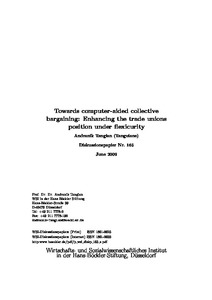Towards computer-aided collective bargaining: enhancing the trade unions position under flexicurity
"The paper develops a negotiation model for flexicurity-relevant collective bargaining. Flexicurity is a European labour market policy which should compensate the ongoing flexibilization of employment relations by advances in employment security and social security. Flexibility is promoted by e...
| Main Author: | |
|---|---|
| Institution: | ETUI-European Trade Union Institute |
| Format: | TEXT |
| Language: | English |
| Published: |
Düsseldorf
2009
HBS |
| Subjects: | |
| Online Access: | https://www.labourline.org/KENTIKA-19178373124919965559-Towards-computer-aided-collect.htm |
| Summary: | "The paper develops a negotiation model for flexicurity-relevant collective bargaining. Flexicurity is a European labour market policy which should compensate the ongoing flexibilization of employment relations by advances in employment security and social security. Flexibility is promoted by employers, whereas trade unions are concerned with security.
First, the opposite interests of negotiating sides are expressed by indicators which evaluate flexibility and security aspects of a collective labour agreement (CLA). A fair agreement should have 0-balance, by analogy with credit-debit 0-balance in finances. Since the flexibility and security indices are expressed in different scales ('in different currencies'), the substitution rate ('exchange rate') should be determined. In our case it is done by regression analysis of flexicurity-relevant CLAs from the past practice. The data are taken from the Dutch computer archive of about 5400 CLAs in years 1995 - 2007. For a given CLA, a positive deviation from the flexibility-security 0-balance means that flexibilization issues are well compensated by security measures (better than on the average). A negative deviation means that flexibility prevails over security, implying that trade unions are disadvantaged. The model outputs tables and graphics and can be regarded as a kind of interactive check-list. It shows shortages and advantages of a given collective agreement with several indices, and displays its relative position with regard to all reference CLAs considered, to those of the given year, to those within the branch, or within the branch in the given year. Finally, the total evaluation of the CLA is made in terms of so called flexicurity balance. This approach can be easily extended to issues beyond flexibility and security.
Besides pragmatic goals, the study provides empirical evidence of increasing flexibility at the price of security. This is a serious warning against improper implementation of flexicurity and one-sided use of this policy in favor of employers. The computer tool developed is just aimed at enhancing the position of trade unions to the end of surmounting this negative trend." |
|---|---|
| Physical Description: | 155 p. Digital |

